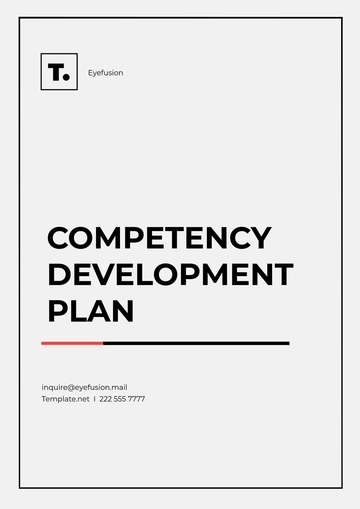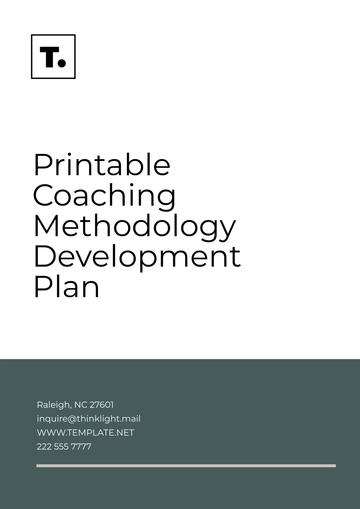Free Strategic Business Development Plan

Prepared by: | [YOUR NAME] |
|---|---|
Company: | [YOUR COMPANY NAME] |
Department: | [YOUR DEPARTMENT] |
Date: | [DATE] |
I. Executive Summary
[YOUR COMPANY NAME] presents its strategic vision to achieve sustainable growth through market expansion and product innovation. The plan outlines key objectives and initiatives to drive revenue growth and enhance market competitiveness.
II. Company Analysis
A. Mission and Vision Statement
Mission: To deliver innovative solutions that empower businesses to thrive in a rapidly changing market.
Vision: To become the industry leader in providing cutting-edge technology solutions worldwide.
B. Core Values
Customer-centricity
Innovation
Integrity
Collaboration
C. SWOT Analysis
Strengths | Weaknesses | Opportunities | Threats |
|---|---|---|---|
Strong brand reputation | Limited market penetration | Emerging markets | Intense competition |
Robust product portfolio | Dependence on key suppliers | Strategic partnerships | Economic downturns |
Experienced management team | High operational costs | Technological advancements | Regulatory changes |
III. Market Analysis
A. Target Market
Our target market includes small to medium-sized enterprises (SMEs) in the technology, healthcare, and finance sectors.
B. Industry Trends
Increasing demand for cloud-based solutions
Growing importance of cybersecurity
Shift towards subscription-based services
C. Competitor Analysis
Competitor | Strengths | Weaknesses | Market Position |
|---|---|---|---|
[COMPETITOR 1] | Strong brand presence | Limited product range | Market leader in the healthcare sector |
[COMPETITOR 2] | Innovative solutions | Lack of global presence | Strong foothold in the finance industry |
[COMPETITOR 3] | Cost-effective pricing | Limited scalability | Emerging player in the technology sector |
IV. Strategic Goals and Objectives
A. Long-term Goals
Achieve 20% year-over-year revenue growth.
Expand market reach to target new geographic regions.
B. Short-term Objectives
Increase customer retention rate by 15% within the next 12 months.
Launch two new product lines by the end of the fiscal year.
C. Key Performance Indicators (KPIs)
Revenue growth rate
Customer acquisition cost
Customer lifetime value
V. Strategic Initiatives
A. Market Expansion Strategies
Establish strategic partnerships with local distributors.
Launch targeted marketing campaigns in key regions.
B. Product Development Strategies
Conduct market research to identify customer needs.
Invest in R&D to enhance existing products and develop new offerings.
C. Sales and Marketing Strategies
Implement a referral program to incentivize customer referrals.
Enhance online presence through SEO and social media marketing.
D. Partnership and Collaboration Strategies
Form alliances with complementary businesses to offer bundled solutions.
Collaborate with universities for talent acquisition and research partnerships.
VI. Financial Plan
A. Revenue Projections
Year | Projected Revenue (USD) |
|---|---|
2065 | $5,000,000 |
2066 | $6,000,000 |
2067 | $7,200,000 |
B. Budget Allocation
Expense Category | Allocation (%) |
|---|---|
Marketing | 30 |
R&D | 20 |
Sales | 25 |
Operations | 15 |
Miscellaneous | 10 |
C. Investment Plans
Secure funding for R&D initiatives through venture capital partnerships.
Explore opportunities for mergers and acquisitions to accelerate growth.
VII. Implementation Plan
A. Timeline
Q1: Conduct market research and analysis.
Q2: Develop and finalize strategic plan.
Q3: Begin implementation of marketing and sales initiatives.
Q4: Monitor progress and make adjustments as necessary.
B. Responsible Parties
CEO: Overall strategic direction and decision-making.
CMO: Marketing strategy and execution.
CFO: Financial planning and budget management.
C. Resource Allocation
Allocate human, financial, and technological resources as needed to support strategic initiatives.
VIII. Monitoring and Evaluation
A. Regular Review Process
Monthly meetings to review KPIs and performance metrics.
Quarterly strategy sessions to assess progress towards goals.
B. Performance Tracking
Sales Performance: Monitor monthly sales figures and compare them against targets to assess performance.
Customer Engagement: Track customer feedback and engagement metrics on social media, website, and other channels.
Market Share: Regularly assess market share compared to competitors in key target markets.
C. Adjustment Strategies
Agile Approach: Implement an agile approach to quickly adjust strategies based on market feedback and performance metrics.
Continuous Improvement: Continuously seek feedback from customers and employees to identify areas for improvement.
Market Analysis: Conduct regular market analysis to stay abreast of changing trends and adjust strategies accordingly.
IX. Risk Management Plan
A. Identification of Potential Risks
Market fluctuations
Regulatory changes
Cybersecurity threats
B. Mitigation Strategies
Diversification of revenue streams
Compliance with industry regulations
Implementation of robust cybersecurity measures
C. Contingency Plans
Establish emergency funds to mitigate financial risks.
Develop crisis communication protocols to address unforeseen events.
X. Conclusion
In conclusion, the Strategic Business Development Plan outlines our roadmap for achieving sustainable growth and maintaining our competitive edge in the marketplace. By focusing on market expansion, product innovation, and strategic partnerships, we aim to capitalize on emerging opportunities and overcome potential challenges.
- 100% Customizable, free editor
- Access 1 Million+ Templates, photo’s & graphics
- Download or share as a template
- Click and replace photos, graphics, text, backgrounds
- Resize, crop, AI write & more
- Access advanced editor
Propel your business forward with the Strategic Business Development Plan Template, exclusively offered by Template.net. Editable in our Ai Editor Tool, this template offers comprehensive customization options. Tailor your business development strategies to perfection and achieve your growth objectives with this versatile and customizable tool. Get it now, for free!





























